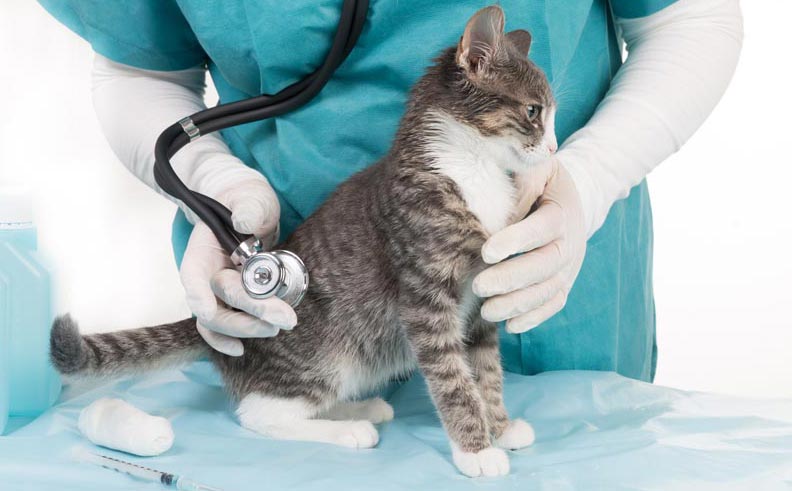Parasites - View from the Vet
Outside adult cats, especially, are susceptible to a variety of parasitic problems, as are kittens.

View from the Vet: Parasites - Cats
Dawn Truesdale, DVM
Parasites – Cats
Along with geographic location, seasons matter with respect to our cats’ health. Summer entices our feline housemates with dreams of adventures outside, some realized and some not. It is a warm season when health risks can rise exponentially with respect to parasites and the potential for disease that arrives with these interlopers. Outside adult cats, especially, are susceptible to a variety of parasitic problems, as are kittens. In this column, I will discuss how I identify – and treat – the parasites that cats are most at risk for, based on my experience in our practice.
1. Fleas
Topping the chart as the most prevalent parasite is the pernicious flea which is most commonly found in cats of all ages, young to old. Fleas are an equal opportunity pest, moving from an outdoor cat to an indoor one with no hesitation. They have a defined life cycle, starting with an adult flea that feeds on the blood of the cat, lays eggs, and leaves feces for the immature stages to feed on. These eggs hatch based on temperature, humidity and vibrations in the environment. The emergent fleas, in turn, lay more eggs. This means combating an infestation is not a one-and-done deal, but can take 3-6 months of treatment to break the cycle.
Signs of fleas may include itching and/or chewing especially around the tail or rear end, but can be very serious, resulting in anemia due to blood loss, particularly in kittens and debilitated cats. Treatment may be oral or topical, usually given once a month, preferably administered routinely throughout your cat’s life. Many owners investigate both prescribed and over-the-counter (OTC) options, with price being a major consideration. Price, however, cannot guarantee the efficacy of OTC treatments. Instances of diverted, repackaged or tampered with products are not unknown. Personally, I recommend nationally recognized brands, approved by the FDA or EPA, obtained through your vet. If you would like to explore over the counter options, look for a company that both dispenses to veterinarians and also sells direct to the public.
Side effects of these legitimate treatments are low, and may be more prevalent in older cats with health issues. In some such cases, flea treatment is NOT advised for an older feline. Check with your vet if your cat has – or has had – health concerns and is older than ten years.
2. Tapeworms
Tapeworms follow logically after fleas in this discussion, because the most common tapeworm seen in our practice reside in the GI tract of the flea. Cats that eat fleas or prey infested with fleas may end up with tapeworms. Symptoms of infestation in your cat are nil. Detection usually occurs when sticky segments of the tapeworms are observed around the rectum or in vicinity of the rear end.
Treatment can be a one time injection or an oral medication obtained from your vet. Vigilance thereafter is required, though, as the tapeworms may return if your kitty is re-exposed or left untreated for fleas.
3. Ticks
Good news! Cats are mildly resistant to ticks, so they are much less often infested than dogs. However, if your kitty likes to hunt outside or enjoys playing in tall grasses or wooded areas, ticks are still a possibility. They become affixed to the skin and, besides sucking blood, can harbor diseases. If you discover a tick on your cat, remove it carefully by pulling it off whole (try to pry away from the skin with the head intact) and destroying it, preferably by flushing down a toilet, immersing in alcohol, or placing in a sealed bag.
Post a tick’s removal, monitoring is recommended to ensure there are no adverse effects. Examine the site in the days that follow. Sometimes post-removal, inflammation at the place where the tick attached itself to the skin may appear as a small benign nodule, not a serious problem. However, if your cat should appear unwell, consult your vet.
4. Mites
There are several types of mites that your kitty can host. One type – ear mites – is familiar to cat owners whose felines are pawing or scratching frequently at one or both of their ears. Close examination usually reveals black ear “dust” and/or sores from scratching. Usually all that is needed is a single dose of anti-parasitic medicine and the ear mites quickly disappear. Occasionally, if heavily infested, a second dose re-applied 30 days later takes care of the problem.
Another mite that is encountered, most often among homeless or free-roaming cats, is Cheyletiella, often referred to as “walking dandruff.” This mite causes itching and hair loss. It can be zoonotic, or transferable to humans. Fortunately, there is a quick fix for an infected cat – a single dose of Frontline. Some veterinarians may choose to use another medicine, Revolution, however it should be noted that while this drug is effective, its use for mites is “off label,” or not specified for this parasite by the drug manufacturer.
Finally, we will discuss the Sarcoptes mite which causes sarcoptic mange or scabies. It is zoonotic, so treatment is imperative. The recommended approach can include weekly lime-sulfur baths, or use of anti-mite drugs called avermectins. A treatment that has previously been mentioned –Revolution – is in this class of drugs and has proven to be very effective against this mite as well as multiple other parasites. It is my go-to treatment when an anti-parasitic solution is required for mites.
5. Cuterebra
As this discussion moves through the most to least prevalent parasites that infect the kitties in our practice, cuterebra needs to be mentioned. Usually easily detected, it manifests as an open or non-healing wound that, when explored, contains a fly larvae or maggot, most commonly on the head/neck or in the nostril of the cat. The larvae must be very carefully removed, because rupturing them can cause a serious reaction in your cat. No one looks forward to tackling this parasite, as it is very physically unappealing to see. However, successful removal of the maggots, coupled with intensive treatment of the underlying wound, can eradicate this condition quite successfully.
6. Roundworms, Hookworns and Whipworms
These parasites are all nematodes which exist in our environment. All of them require fecal tests to be confirmed definitively.
Roundworm infection occurs through contact with feces of other infected animals or through eating infected animals or their feces. Left untreated, roundworms in cats can be deadly with severe cases causing intestinal blockages and rectal prolapse. Sources of roundworms can be many. It is not widely known that potting soil, sold commercially, can be infected with Roundworm eggs. A cat that chooses to use a potted plant as a litter box can become infected, as can a cat or kitten that hunts outside or plays with bugs. Young kittens also can be infected via an infected mother.
Symptoms from Roundworms typically involve the GI tract, causing diarrhea,vomiting and/or passage of spaghetti-like worms in feces. An infection may also cause lethargy and abdominal swelling (a pot-bellied appearance), especially in kittens. One type of roundworm involves migration through the lungs which can cause a cough as well.
My go-to medicines are Revolution administered topically and an oral dewormer which evicts the roundworms from the cat’s intestines. Both medications work well, though it may take multiple rounds of meds for your cat to become parasite-free. It may be worthwhile to consider a once-monthly treatment as cats can become reinfected.
To note, roundworms are also a human health concern and these parasites, if ingested, can migrate through human internal organs, so please be sure to do routine fecal checks on your cats.
Hookworm infections are caused through acquisition of hookworm larvae that have hatched from eggs. A kitty can become infected if they ingest them directly from licking or grooming when or where the larvae are present. The worms also can be obtained when an infected rodent or cockroach is eaten. Too, they are known to migrate through the skin or paw pads.
Hookworms are strictly intestinal. In the intestines, they develop into adults and feed on blood and tissue. Hookworms, being small, thin worms less than an inch long, are mobile and so can detach, leaving behind ulcers, as they move to other locations in the intestine.
Hookworm symptoms depend on the type of hookworm. One type can cause fatal blood loss in kittens, if a heavy infection. Other types are less threatening and normally cause mild disease. The severity of the disease depends not only upon the type of hookworm – and the suspected quantity – but also the age and previous health of your cat. Symptoms can include anemia, bloody or tarry stools, diarrhea, weight loss, and skin irritation, especially between the toes due to migrating larvae.
Suspected hookworms warrant a visit to your vet. Most likely the vet will require a stool sample and that will permit detection under a microscope. Once confirmed, the treatment is started and repeated, this being necessary to deal with the larvae which mature at two-week intervals. The number of treatments necessary will depend on the age and health of your cat and is best determined by your vet. Post eradication of the hookworm, I highly recommend a regular monthly medication for parasite control for all healthy felines.
Know that humans can become infected too. Though the larvae do not develop into adult hookworms in people, the larvae migrating through the skin can cause irritation and inflammation. Though not normally serious, it is recommended that an owner of a cat infected with hookworm consult a medical doctor for advice.
Whipworms – curvy, whip-shaped parasites -- by comparison are rare in cats, but they can infect felines regardless of age or gender. Diarrhea, bloody diarrhea, anemia, dehydration and weight loss are symptoms. These worms are most often detected through an annual fecal test performed by your vet. If discovered, there is no specific treatment for whipworms in felines, but deworming treatment used for dogs can be effective. It is a long row-to-hoe when treating this parasite, so I always support and encourage an owner to be patient and stick to the months’ long regimen prescribed. It is extremely important to keep the cat’s environment clean during treatment, so I advise frequent cleaning of the litter box with soap and water. Outdoor cats will require that all their feces are removed from the area. With treatment, repeated fecal exams and a hygienic habitat, your kitty can whip the whipworm eventually.
7. Giardia
While not extremely common in cats, Giardia is an important parasite to discuss. Giardia is an intestinal parasite causing inflammation and decreased aborption of nutrients in the intestines which may be virtually asymptomatic in cats with normal immune systems. However, in kittens or cats with low or compromised immunity, it may produce diarrhea, sometimes straining, and if protracted or chronic, weight loss usually despite a good appetite. Giardia is considered of importance from a zoonotic standpoint, so proper handling of fecal material and cleaning of the environment is very important. Your vet will require a stool sample for a definitive diagnosis and, if confirmed, will prescribe appropriate treatment. The treatment may vary based on the age and condition (I.e pregnancy) of your cat. Fortunately, the treatment cycle for Giardia is short and usually effective. However, reinfection is possible.
8. Lungworm
Lungworm is not a commonly occurring parasite in my Midwest practice area. However, it does occur elsewhere so I will briefly discuss here. Lungworm is a byproduct of your outdoor kitty ingesting rodents and birds that have eaten slugs or snails that are inflected with this parasite. Many cats show no symptoms. However, young cats or those with weakened immune systems may display one or more upper respiratory problems. These can include wheezing, coughing, shortness of breath, or difficulty in breathing, which can be severe. The diagnosis is confirmed with respiratory bronchial lavage, allowing for clear identification of the worm. It may be treated with anti-parasitics, such as Revolution, which will kill the worms, though it may take several treatments to totally eradicate the infection. As an after-effect of lungworm, your kitty may be left with mild breathing issues that, while not debilitating, could be long lasting.
9. Toxoplasmosis
An important parasite of cats, Toxoplasmosis gets lots of attention in the press. However, in my sixteen years of practice, I’ve only seen only one or two clinical cases. This would seem to indicate that it is not a rampant disease nor widespread.
What exactly is Toxoplasmosis? It is a parasite that may be contracted by your cat through either capture and kill of an infected animal; eating a raw diet; ingesting things contaminated with feline feces, such as soil, water, or plants; or, occasionally, transmission from mother to offspring through the placenta or nursing. Symptoms are usually seen in immune-compromised cats where, because it is a multi-systemic infection, worrisome signs usually correspond to the organ that has been infected. These organs commonly include lymph nodes, liver, lung, brain, spinal cord, eyes and also the heart.
Diagnosis is difficult. Basically, a definitive diagnosis relies on identifying oocysts in the cat’s feces. However, this “shedding” of the oocysts is short-lived once a cat shows symptoms. Too, in asymptomatic kitties, they tend to shed in low volumes and also infrequently, making it even more difficult to pinpoint the culprit. Some vets will measure antibody titers using a blood test, but this test also has its problems because it cannot show whether or not a cat is infectious to humans. This is because a positive titer does not indicate that a cat is shedding oocysts, just that the cat has been exposed to Toxoplasmosis sometime in its life. Most cats with positive titers are past the shedding phase and not a source of concern for humans.
Prevention requires that any opportunities for exposure be eliminated – prevent hunting outside, do not feed raw or undercooked meats, feed a commercially prepared diet, clean litter boxes daily to ward off the likelihood of oocysts becoming infectious, and disinfect litter boxes periodically with very hot water.
Direct contact with cats is NOT considered a risk factor for Toxoplasmosis transmission to humans, contrary to some peoples’ beliefs. Cats showing clinical signs of the disease are usually not shedding oocysts in their feces and therefore are not a human health concern. Cats that are shedding cysts which can be infectious to humans will be asymptomatic which is the real concern. Cysts shed in feces become infective in 1-5 days and can persist for months in the environment. This means that certain precautions are required of pregnant women and immune-compromised individuals who own or plan to own a cat: no cleaning of litter boxes, along with a recommendation to adopt older, mature cats versus kittens, as they are less likely to be shedding oocysts. In fact, you are far more likely to contract Toxo from outdoor gardening or consumption of undercooked meat than from your indoor-only house cat! I would recommend that you adopt good hygienic practices too, including wearing gloves while gardening or thoroughly washing hands afterwards, cleaning cutting boards well after use, cooking food thoroughly, washing fruit and vegetables before consumption, and managing the external environment at your residence (i.e. covering an outdoor sandbox when not in use).
10. Heartworms
I am ending this discussion of parasites in cats with an infection by a worm that can be prevented, but unfortunately not treated.
A lethal parasite, heartworm begins with an infection by a worm which is transported by infected mosquitos. If your kitty is bitten and infected, it may exhibit vomiting and asthma-like coughing as a result. These symptoms, however, can mimic many other infections. Relying on a combination of diagnostic approaches, heartworm can often be definitely diagnosed by your vet, although false negatives do occur. Sadly, because there is no cure, treatment is aimed at minimizing the symptoms experienced as a result of the cat’s body trying to evict the worms, namely anti-inflammatory medications for coughing and anti-nausea medications for vomiting. The scariest part of this disease is that often it is asymptomatic and the cat may die suddenly. That being the case, I cannot emphasize enough the need for oral or topical heartworm preventives of which there are several great ones in the market available from your veterinarian.
And in conclusion………
I hope this summary discussion of parasites has been helpful in giving you, a devoted pet caregiver, a perspective on a subject that deserves your attention. As an owner of one or more devoted felines, I encourage you to be conscientious with respect to observing your cat’s appetite, behavior, skin condition, bathroom habits and general overall health. You are the first line of defense in ensuring good health and longevity for your kitty. Parasites can be nasty buggers but, if caught early, most can almost always be cured. Knowing that, a little extra observation can be the difference between a healthy feline and one that isn’t.
______________
Dawn Truesdale is a practicing vet affiliated with Linworth Animal Hospital in Worthington, Ohio. A graduate of Ohio State University College of Veterinary Medicine, Dawn has sixteen (16) years experience in emergency medicine and general practice. She is an avowed animal advocate and board member of the Animal Protection Network (APN).The body content of your post goes here. To edit this text, click on it and delete this default text and start typing your own or paste your own from a different source.
Want to help?
Join us at our upcoming
events to make a difference
in central Ohio!

Learn how, then teach others about how TNVR benefits cat colonies and the communities they live in.

Help us provide seminars to educate the public on topics that promote animal rights, health and safety.

Spread the word of APN at community festivals. It's a fun way to help the Animal Protection Network grow to save local animals in need!
Volunteer Or Join Our Mailing List!
We will get back to you as soon as possible
Please try again later




